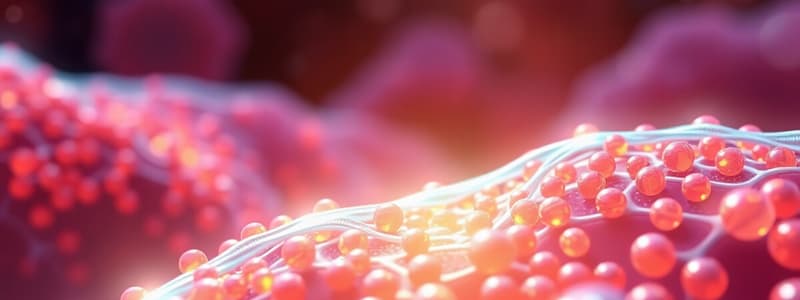Podcast
Questions and Answers
What is the primary difference between passive transport and active transport?
What is the primary difference between passive transport and active transport?
- Passive transport moves molecules against their concentration gradient.
- Active transport does not require energy, while passive transport does.
- Passive transport uses transmembrane proteins, and active transport does not.
- Active transport requires energy, whereas passive transport does not. (correct)
Facilitated diffusion requires the usage of ATP.
Facilitated diffusion requires the usage of ATP.
False (B)
What term describes the process where cells engulf large particles such as bacteria?
What term describes the process where cells engulf large particles such as bacteria?
Phagocytosis
Active transport moves molecules from an area of _____ concentration to an area of _____ concentration.
Active transport moves molecules from an area of _____ concentration to an area of _____ concentration.
Match the following terms with their definitions:
Match the following terms with their definitions:
What is the primary function of receptors in cell communication?
What is the primary function of receptors in cell communication?
Oil and water mix well because oil is polar and water is nonpolar.
Oil and water mix well because oil is polar and water is nonpolar.
What is the structure formed by phospholipids in the cell membrane?
What is the structure formed by phospholipids in the cell membrane?
________ transport is the movement of molecules across a cell membrane that requires no energy.
________ transport is the movement of molecules across a cell membrane that requires no energy.
Match the type of solution with its description:
Match the type of solution with its description:
What describes the fluid mosaic model of the cell membrane?
What describes the fluid mosaic model of the cell membrane?
Osmosis involves the movement of water from an area of high solute concentration to low solute concentration.
Osmosis involves the movement of water from an area of high solute concentration to low solute concentration.
What is the role of cholesterol in the cell membrane?
What is the role of cholesterol in the cell membrane?
Flashcards
Passive Transport
Passive Transport
Movement of molecules across a membrane from an area of high concentration to low concentration, without requiring energy.
Facilitated Diffusion
Facilitated Diffusion
A type of passive transport where molecules move across a membrane with the help of a protein.
Active Transport
Active Transport
Movement of molecules across a membrane against their concentration gradient, requiring energy from ATP.
Endocytosis
Endocytosis
Signup and view all the flashcards
Exocytosis
Exocytosis
Signup and view all the flashcards
Receptor
Receptor
Signup and view all the flashcards
Selective permeability
Selective permeability
Signup and view all the flashcards
Diffusion
Diffusion
Signup and view all the flashcards
Concentration gradient
Concentration gradient
Signup and view all the flashcards
Osmosis
Osmosis
Signup and view all the flashcards
Isotonic solution
Isotonic solution
Signup and view all the flashcards
Hypotonic solution
Hypotonic solution
Signup and view all the flashcards
Study Notes
Cell Communication & Membrane Structure
- Cells communicate through chemical signals recognized by specific receptors (proteins).
- Receptor binding triggers internal cellular responses.
- Polar molecules (e.g., water) and nonpolar molecules (e.g., oil) have different properties impacting their interactions.
- Water is polar, having positive and negative ends, while oil is nonpolar, with balanced charges. This leads to repulsion between water and oil.
Phospholipids & Cell Membranes
- Phospholipids are both polar and nonpolar, forming a bilayer crucial for cell membranes (polar heads face out, nonpolar tails face in).
- The fluid mosaic model describes the cell membrane as a flexible structure where phospholipids and proteins can move.
- Cholesterol is also present in the membrane, influencing its fluidity.
- The membrane selectively allows certain materials across, crucial for maintaining a different internal environment to the exterior.
Passive Transport Mechanisms
- Diffusion is the passive movement of molecules from higher to lower concentration until evenly distributed.
- Some molecules, like oxygen, can diffuse through the phospholipid bilayer.
- Passive transport doesn't require energy and utilizes existing concentration gradients.
- Facilitated diffusion uses membrane proteins to passively transport molecules unable to cross the bilayer directly (specific for certain molecules).
- Osmosis is the passive movement of water across a semipermeable membrane from lower to higher solute concentration.
Types of Solutions in Osmosis
- Isotonic solutions have balanced solute concentrations across the membrane, so water movement is balanced.
- Hypotonic solutions have lower solute concentration outside the cell, causing water to move into the cell.
- Hypertonic solutions have higher solute concentration outside the cell, driving water out of the cell.
Active Transport
- Active transport requires energy (ATP) to move molecules against their concentration gradient (low to high).
- Transmembrane proteins, often called protein pumps, facilitate active transport.
Bulk Transport: Endocytosis & Exocytosis
- Endocytosis brings materials into the cell by forming vesicles from the membrane.
- Phagocytosis (cell eating) is a type of endocytosis for engulfing larger particles (e.g., bacteria).
- Exocytosis releases materials from the cell by fusing vesicles with the membrane.
- Exocytosis and endocytosis require energy (ATP).
Studying That Suits You
Use AI to generate personalized quizzes and flashcards to suit your learning preferences.




